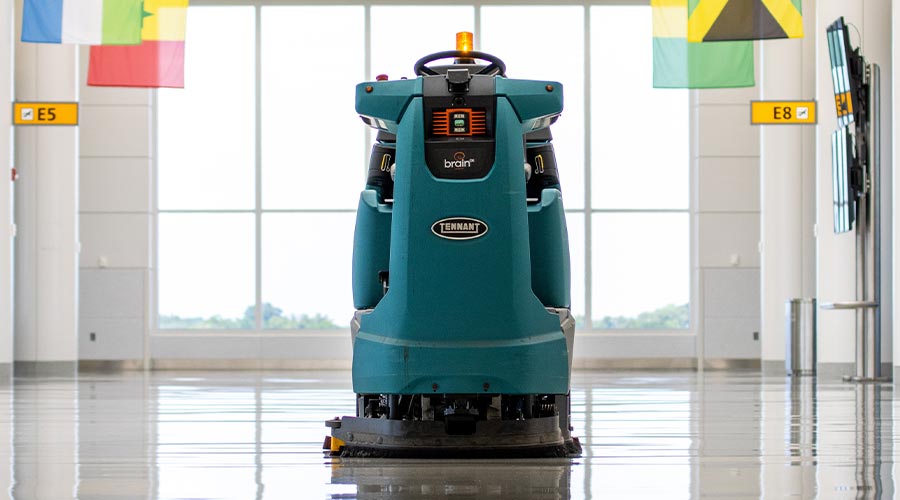
Technological advancements in floor cleaning equipment have enabled BCSs to address some primary concerns, one of which is labor shortages. This is where robotics are primed to step in, opening the door to streamlining contracts and allowing frontline cleaning teams to accomplish more with fewer people.
Consider autonomous floor scrubbers. Outfitted with advanced sensors, cameras, robotics and artificial intelligence (AI), they are especially useful for facilities such as warehouses or retail spaces that feature vast amounts of open flooring, but also in buildings with complex layouts. Unlike humans who call in sick or suddenly quit, these battery-powered machines are always on the job and can run continuously. Once a facility is mapped, the machines can be programmed to follow specific cleaning patterns, yet are sophisticated enough to detect changes in the environment or obstacles in their path and respond accordingly.
Such equipment not only allows BCSs to realize greater efficiencies and more reliable results, but they save labor costs as well. And since manually cleaning large or complicated spaces can be physically taxing, autonomous scrubbers also reduce the risk of workplace injuries, and subsequently, workers compensation claims. These machines are also designed to be more energy efficient and environmentally sustainable since they typically use less water and fewer chemicals and are outfitted with longer-life-cycle batteries.
But what makes robotic machines so appealing isn’t necessarily that they clean better or faster than humans, says Keller. Instead, it’s their consistency and the ability to collect and provide data analytics that he considers the main advantages.
“Providing your client with a report that details which specific areas were cleaned is a huge value-add to a contractor,” he explains. “Being able to report that a specific space was not cleaned because someone left an obstruction in the way completely changes the conversation with the customer. Analytics provides all that information at no additional cost.” (It should be noted that most robotic floor cleaners claim the ability to navigate around obstacles, both mapped and unexpected, but they still cannot physically move an obstruction.)
Although end users are seeing advantages to using autonomous equipment, experts stress that the machines are not necessarily a good fit for all spaces. Small spaces or those with many obstacles are better cleaned by a person using the right tools. However, for large, open, and obstructed spaces where their use is appropriate, autonomous equipment can streamline processes, subsequently helping BSCs navigate labor shortages and pressures they’re facing like increases in wages and benefits.
Another innovation — not necessarily recent, but it is being fine-tuned — is battery-operated equipment such as vacuums, scrubbing tools, and finish applicators, says Luallen. These allow cleaning technicians to tackle their jobs quicker and with less fatigue, potentially helping to mitigate some of the aforementioned labor concerns.
“There is now wider use of smaller battery-operated cleaning equipment that can agitate baseboards, navigate around toilets, and even tackle stair treads,” he adds. “These tools are becoming more standard for most companies because of their efficiencies and ergonomic advantages.”
Battery-operated machines allow manufacturers to devise lighter, more compact and productive, and more ergonomic equipment compared to their corded counterparts. Cordless machines are also safer for workers and building occupants. By eliminating the tripping worry that cords pose, workers have greater flexibility as to when and where they are able to clean. As such, manufacturers are bringing more battery-operated equipment to market, with some of those who formerly focused on the home space now introducing “more robust offerings” for commercial use, says Keller.
What other shifts are happening?
Luallen says the growing prevalence of textured flooring has sparked greater use of counter-rotating brush machines, as well as brush heads for rotary equipment. And Keller anticipates that equipment manufacturers will begin to offer a broader selection of softer brushes and pads.
“This need is specifically tied to the trends of luxury flooring entering the commercial workspace,” Keller explains. “We also expect to see more equipment designed to use less water and limit the moisture on the floor — luxury vinyl plank flooring is advertised as waterproof and durable; we are finding this is not always the case. This will ensure that the luxury substrates entering the market will last for a long time.”
Pamela Mills-Senn is a freelance writer from Long Beach, California, and a frequent contributor to Contracting Profits.
Cleaning Solutions for Evolving Flooring Types

 The Down and Dirty on Cleaning in Virus Season
The Down and Dirty on Cleaning in Virus Season How Surfactant Use is Expanding in Commercial Cleaning
How Surfactant Use is Expanding in Commercial Cleaning